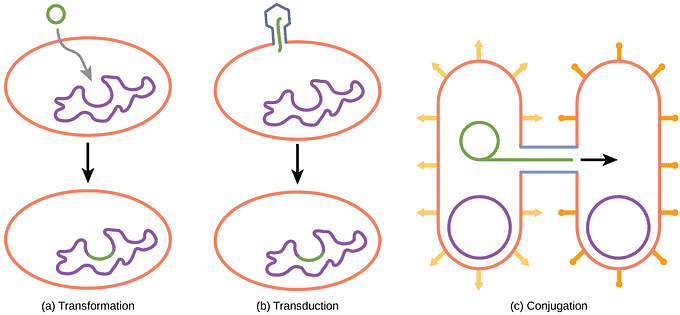Prokaryotic Cells: Cell Envelope, Ribosomes & Inclusion Bodies | Science for ACT PDF Download
Cells are like the basic building blocks of life, and they have shapes and sizes. We can group cells into two main categories based on their structure: Prokaryotic and Eukaryotic cells.
In this document we will study about prokaryotic cells in detail.
What is Prokaryotic Cell?
The term "pro" signifies "before," and "kary" refers to the "nucleus." Prokaryotes are basic, single-celled life forms, and they represent the most primitive form of life on our planet.
Prokaryotic cells are the type of cells that do not have a well-defined nucleus and no membrane-bound organelles. Organisms with Prokaryotic cells are called prokaryotes and they are generally single-celled microorganisms.
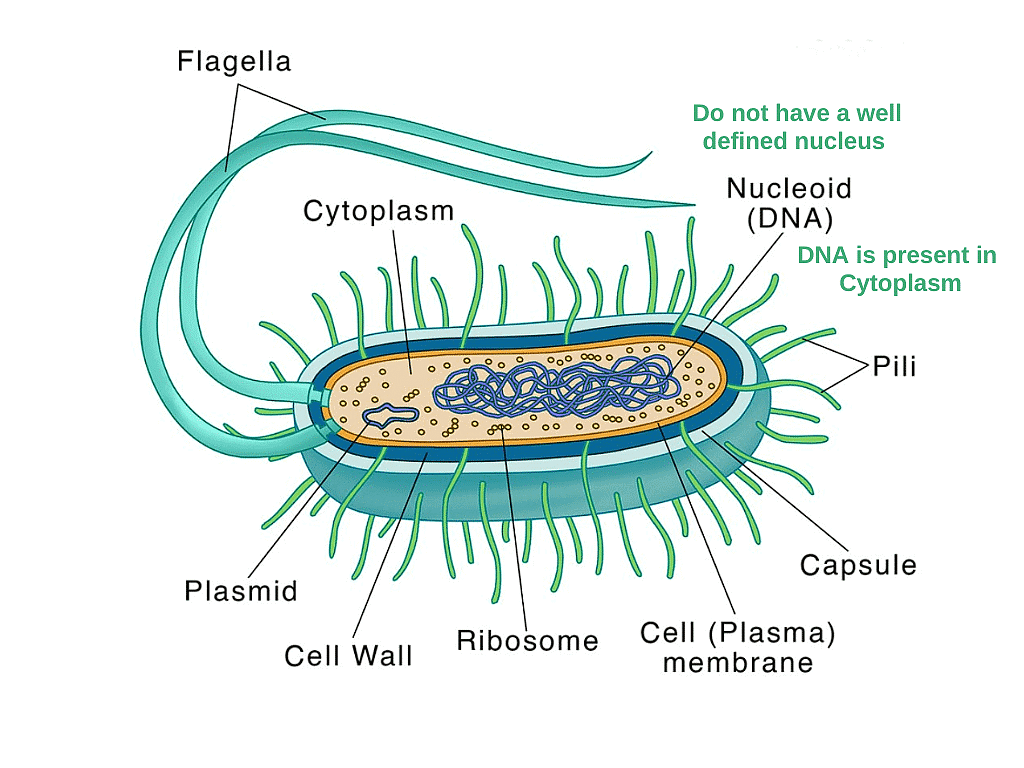 Prokaryotic Cell
Prokaryotic Cell
Where are Prokaryotes Found?
Prokaryotes are tiny organisms that can live in lots of places, like on land, in water, in the air, and even inside living things, including us humans. Scientists have found evidence that these tiny creatures have been around for a really, really long time—around 3.5 billion years!
Components of Prokaryotic Cell Structure
(a) Nuclear Material
- DNA is naked and lies variously coiled in the cytoplasm.
- It is often called genophore, nuclear body or nucleoid.
- It is equivalent to a single naked chromosome and is, therefore, also called a prochromosome.
- Many procaryotes also have additional small circular DNA entities called plasmids.
- Plasmids carry additional specific factors like nitrogen fixation, resistance, fertility, etc.
(b) Cell Wall
- It is present in bacteria and cyanobacteria.
- A cell wall is absent in mycoplasma or PPLO.
(c) Flagella and Fimbriae
Flagella are present in some bacteria only and the bacterial flagella are single-stranded as compared to the 11-stranded flagella of eukaryotes.
 Flagella and Fimbriae
Flagella and Fimbriae
- In some bacteria, non motile appendages called pili or fimbriae also occur.
- Pili and Fimbriae are surface structures of bacteria but do not play a role in motility.
Pili are elongated tubular structures made of a special protein. Flagella have three parts: filament, hook, and basal body.
Fimbriae are small bristle-like fibers that help attach bacteria to rocks in streams or host tissues in some bacteria. They take part in the attachment (e.g., Neisseria gonorrhoeae) and conjugation (e.g., Escherichia coli).
Flagella have three parts: filament, hook, and basal body.
(d) Photosynthetic Thylakoids
- Blue-green algae and some bacteria are photoautotrophic.
- Their photosynthetic thylakoids lie freely in the cytoplasm.
- They are not organized into chloroplasts.
(e) Membrane-lined Cell Organelles
- The procaryotic (= prokaryotic) cells lack mitochondria, endoplasmic reticulum, Golgi apparatus, lysosomes, microtubules, microfilaments and centrioles.
(f) Vacuoles
- Typical vacuoles are doubtful. Instead, complex gas vacuoles are found.
(g) Ribosomes
- Ribosomes are 70S as compared to 80S.
- Similar 70S ribosomes occur inside chloroplasts and mitochondria of eukaryotes.
(h) One-Envelope System
- In prokaryotic cells, membrane-bound cell organelles are absent so that there is a single membrane that surrounds the cell.
- Hence, procaryotes have a single membrane or one-envelope system.
- Genetic material lies freely in the cytoplasm.
- Eucaryotes have a two-envelope system, the outer plasma membrane contained cytoplasm and the inner nuclear envelope contained genetic material.
Shapes of Prokaryotic Cells
The three most common prokaryotic cell shapes are spiral (coiled-shaped), bacillus (rod-shaped), and coccus (spherical or oval-shaped). Other than the three basic shapes, cells can be sheathed, stalked, filamentous, star-shaped, spindle-shaped, lobed, and pleomorphic, to name a few.
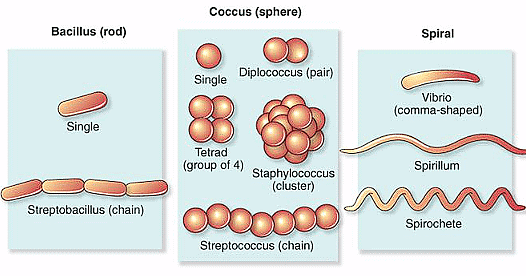 Shapes of cells
Shapes of cells
How Big are Prokaryotic Cells?
Prokaryotic cells, such as bacteria, blue-green algae, mycoplasma, and PPLO (Pleuro Pneumonia Like Organisms), are typically smaller and reproduce faster compared to eukaryotic cells
Typically, prokaryotic cell sizes range from 0.1 to 5.0 μm in diameter and thus are significantly smaller than eukaryotic cells. They have a surface area to volume ratio higher than eukaryotes because of their small size.
Cell Envelope and its Modifications
Prokaryotic cells, like bacterial cells, have a complex cell envelope consisting of three layers: glycocalyx, cell wall, and plasma membrane. These layers work together as a protective unit for the cell. Gram staining can classify bacteria into Gram-positive or Gram-negative based on differences in their cell envelopes.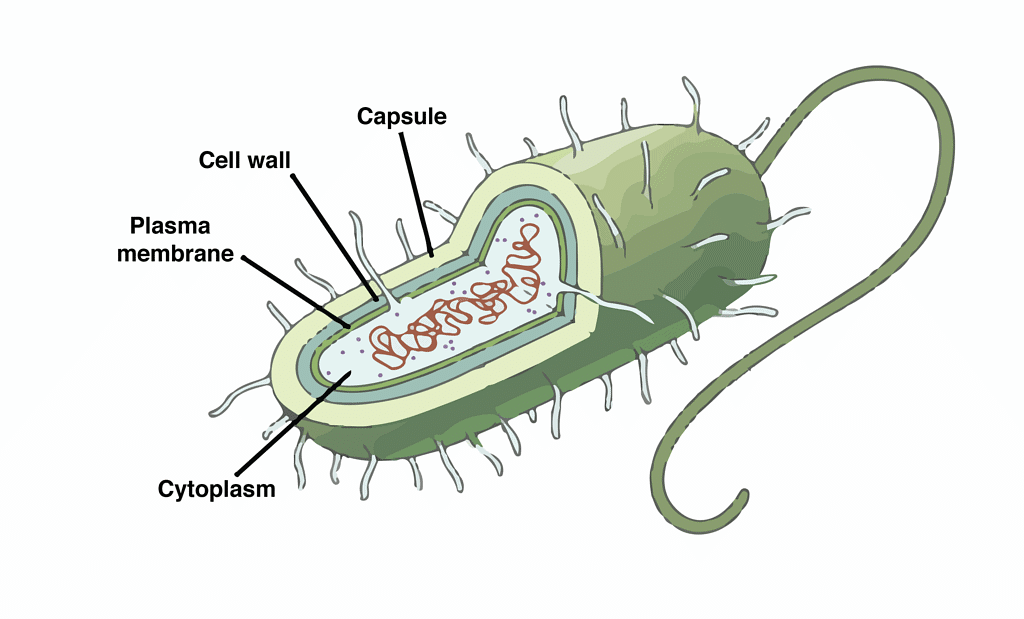 Prokaryotic Cell
Prokaryotic Cell
(a) Glycocalyx
- Glycocalyx is the outermost layer of the cell envelope.
- It can be a loose sheath called the slime layer or a thick and tough capsule.
- Composition and thickness of glycocalyx vary among different bacteria.
(b) Cell Wall
- Cell wall determines the shape of the cell and provides structural support.
- It prevents the bacterium from bursting or collapsing.
(c) Plasma Membrane
- Plasma membrane is selectively permeable and interacts with the outside world.
- Structurally similar to the plasma membrane of eukaryotic cells.
(d) Mesosome and Chromatophores
- Mesosome is a membranous structure formed by extensions of the plasma membrane into the cell.
- These extensions are in the form of vesicles, tubules and lamellae.
- Mesosome helps in cell wall formation, DNA replication, respiration, secretion processes, and increases the surface area of the plasma membrane.
- Chromatophores are membranous extensions into the cytoplasm found in some bacteria, like cyanobacteria, and contain pigments.
Ribosomes in Prokaryotic Cells
- Ribosomes in prokaryotes are associated with the plasma membrane of the cell.
- They are about 15 nm by 20 nm in size and are made of two subunits - 50S and 30S units.
- When present together, they form 70S prokaryotic ribosomes.
- Ribosomes are the site of protein synthesis.
- Multiple ribosomes may attach to a single mRNA, forming a chain called polyribosomes or polysome.
- Polysome ribosomes translate mRNA into proteins.
Inclusion Bodies in Prokaryotic Cells
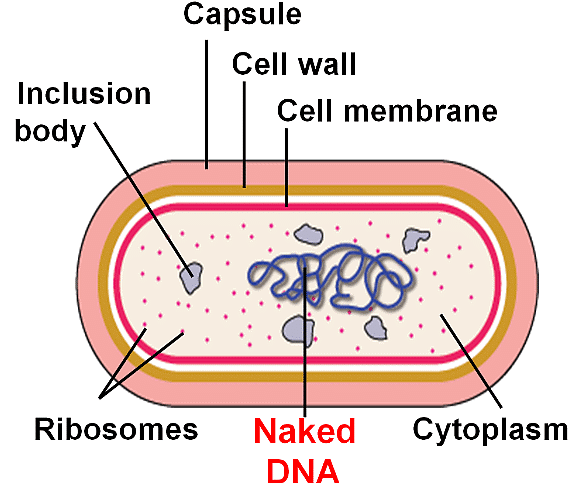 Showing inclusion bodies in the cell
Showing inclusion bodies in the cell
- Reserve materials in prokaryotic cells are stored in the cytoplasm as inclusion bodies.
- Inclusion bodies are not bound by any membrane system and are free in the cytoplasm.
- Examples of inclusion bodies include phosphate granules, cyanophycean granules, and glycogen granules.
Gas Vacuoles in Prokaryotic Cells
- Gas vacuoles are found in blue-green and purple and green photosynthetic bacteria.
- Gas vacuoles are not bound by any membrane system and are free in the cytoplasm.
- Gas vacuoles are involved in buoyancy regulation in bacteria
Examples of Prokaryotic Cells
The examples of the prokaryotic cells are mentioned below:
1. Bacterial Cells
- These are unicellular organisms found everywhere on earth from soil to the human body.
- They have different shapes and structures.
- The cell wall is composed of peptidoglycan that provides structure to the cell wall.
- Bacteria have some unique structures such as pili, flagella, and capsules.
- They also possess extrachromosomal DNA known as plasmids.
- They have the ability to form tough, dormant structures known as endospores that helps them to survive under unfavourable conditions. The endospores become active when the conditions are favourable again.
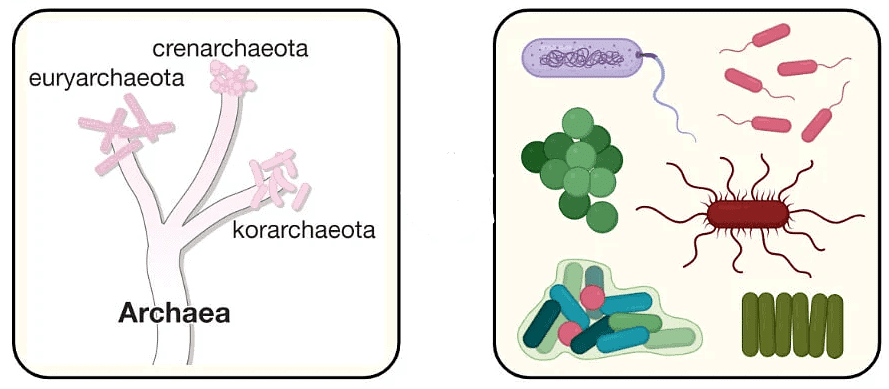 Archea and Bacteria
Archea and Bacteria
2. Archaeal Cells
- Archaebacteria are unicellular organisms similar to bacteria in shape and size.
- They are found in extreme environments such as hot springs and other places such as soil, marshes, and even inside humans.
- They have a cell wall and flagella. The cell wall of archaea does not contain peptidoglycan.
- The membranes of the archaea have different lipids with completely different stereochemistry.
- Just like bacteria, archaea have one circular chromosome. They also possess plasmids.
Additional Information
Reproduction in Prokaryotes
A prokaryote reproduces in two ways:
- Asexually by Binary fission
- Sexually by Recombination
Binary Fission
- The DNA of an organism replicates and the new copies attach to the cell membrane.
- The cell wall starts increasing in size and starts moving inwards.
- A cell wall is then formed between each DNA, dividing the cell into two daughter cells.
Recombination
- In this process, genes from one bacteria are transferred to the genome of other bacteria.
- It takes place in three ways - conjugation, transformation, transduction.
 Recombination process
Recombination process
- Conjugation is the process in which genes are transferred between two bacteria through a protein tube structure called a pilus.
- Transformation is the mode of sexual reproduction in which the DNA from the surroundings is taken by the bacterial cell and incorporated into its DNA.
- Transduction is the process in which the genetic material is transferred into the bacterial cell with the help of viruses. Bacteriophages are the virus that initiates the process.
Previous Year Questions - Prokaryotic Cell
Q1: Which one of the following is not an inclusion body found in prokaryotes ?
(a) Cyanophycean granule
(b) Glycogen granule
(c) Polysome
(d) Phosphate granule
Answer: C
Solution:
- Prokaryotes are the primitive organism which lacks membrane-bounded organelles and nucleus. Prokaryotic cells have some microscopic structures in their cytoplasm.
- They serve specific purposes for the cell. Inclusions are aggregates of specific chemical compounds and often serve as a reservoir of energy or carbon. Common inclusions are poly--hydroxyalkanoate, sulfur globules, cyanophycin globules, and polyphosphate.
- Polyribosomes (or polysomes) also known as ergosomes are a cluster of ribosomes, bound to the mRNA molecule during translation process found in the eukaryotes. Hence, the correct option is C
Q2: Cell wall is absent in :
(a) Funaria
(b) Mycoplasma
(c) Nostoc
(d) Aspergillus
Answer: B
Solution:
The cell wall is the hard protective covering of all plant, fungal and some bacterial cells. Mycoplasma is a genus of bacteria that lack a cell wall and are surrounded by their cell membrane only.

|
486 videos|517 docs|337 tests
|
FAQs on Prokaryotic Cells: Cell Envelope, Ribosomes & Inclusion Bodies - Science for ACT
| 1. What is a prokaryotic cell? |  |
| 2. Where are prokaryotes found? |  |
| 3. What are the components of prokaryotic cell structure? |  |
| 4. What are the shapes of prokaryotic cells? |  |
| 5. What are inclusion bodies in prokaryotic cells? |  |

|
Explore Courses for ACT exam
|

|
